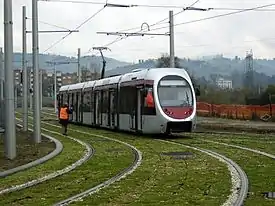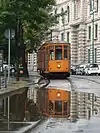Trams in Florence
The Florence tramway network (Italian: Rete tranviaria di Firenze) is an important part of the public transport network of Florence, Italy. It consists of two operational light rail lines.
 | |||
| Overview | |||
|---|---|---|---|
| Locale | Florence, Italy | ||
| Transit type | Tram | ||
| Number of lines | 2 | ||
| Number of stations | 37 | ||
| Daily ridership | 100,000 (2019)[1] | ||
| Annual ridership | 13 million (2015)[2] | ||
| Operation | |||
| Began operation | 14 February 2010 | ||
| Operator(s) | GEST | ||
| Number of vehicles | 17 AnsaldoBreda Sirio | ||
| Train length | 32 m | ||
| Headway | 4–6 minutes | ||
| Technical | |||
| System length | 16.5 km (10.3 mi) | ||
| Track gauge | 1,435 mm (4 ft 8 1⁄2 in)[3][4] | ||
| Electrification | 750 V DC | ||
| Top speed | 70 km/h (43 mph)[4] | ||
| |||
Florence, like many other Italian cities, closed down its old tramway network at the end of the 1950s, but has come back to trams in recent years to find a solution to the rising car traffic in the city. The first line in the present network was opened in 2010 to link the city center with the neighboring comune of Scandicci; the second line opened on February 11, 2019, linking the city center with Florence Airport.
The current network operator is GEST (Gestione Servizio tramviario), a subsidiary of the French RATP.[5]
History
1879–1958
The first horse-drawn tramway in Florence was inaugurated on 5 April 1879. It linked the city center to Peretola. One year later the original line was extended to reach Prato and Poggio a Caiano. The tramway was managed by Società dei Tramways Fiorentini.[6]
In 1898 the company bought out Tranvia del Chianti company and in the same year the lines were electrified.
In 1926 the tram was considered already obsolete, and the first bus routes started. In 1934 the company responsible for the service went out of business.[7]
During the Second World War the tramway was severely damaged, and the network was fully restored only in 1951. From the end of the war the tramway was managed by ATAF. However, after few years the infrastructure was deemed too old and inadequate, and the tramway was definitively closed on 20 January 1958.[8][9][10]
Modern tramway (2010)
During the early 2000s, the Florence administration decided to restore the tram service. Works on the first line started on December 2005.[11] Construction works were expected to last for 1,000 days, but eventually it took more than 1,800 days to complete the line.[12] Line 1 started operation on 14 February 2010. The first part of Line 1, at Scandicci, was the first rail public transport service in the area.
During the first 10 months of service, the total passenger served were 7 million, a result considered a success.[13]
On 16 July 2018 the line was extended from Florence Santa Maria Novella railway station to the current northern terminus, Careggi.
Lines
| Florence tramway network | |||||||||||||||||||||||||||||||||||||||||||||||||||||||||||||||||||||||||||||||||||||||||||||||||||||||||||||||||||||||||||||||||||||||||||||||||||||||||||||||||||||||||||||||||||||||||||||||||||||||||||||||||||||||||||||||||||||||||||||||||||||||||||||||||||||||||||||||||||||||||||||||||||||||||
|---|---|---|---|---|---|---|---|---|---|---|---|---|---|---|---|---|---|---|---|---|---|---|---|---|---|---|---|---|---|---|---|---|---|---|---|---|---|---|---|---|---|---|---|---|---|---|---|---|---|---|---|---|---|---|---|---|---|---|---|---|---|---|---|---|---|---|---|---|---|---|---|---|---|---|---|---|---|---|---|---|---|---|---|---|---|---|---|---|---|---|---|---|---|---|---|---|---|---|---|---|---|---|---|---|---|---|---|---|---|---|---|---|---|---|---|---|---|---|---|---|---|---|---|---|---|---|---|---|---|---|---|---|---|---|---|---|---|---|---|---|---|---|---|---|---|---|---|---|---|---|---|---|---|---|---|---|---|---|---|---|---|---|---|---|---|---|---|---|---|---|---|---|---|---|---|---|---|---|---|---|---|---|---|---|---|---|---|---|---|---|---|---|---|---|---|---|---|---|---|---|---|---|---|---|---|---|---|---|---|---|---|---|---|---|---|---|---|---|---|---|---|---|---|---|---|---|---|---|---|---|---|---|---|---|---|---|---|---|---|---|---|---|---|---|---|---|---|---|---|---|---|---|---|---|---|---|---|---|---|---|---|---|---|---|---|---|---|---|---|---|---|---|---|---|---|---|---|---|---|---|---|---|---|---|---|---|---|---|---|---|---|---|---|---|---|---|---|
| |||||||||||||||||||||||||||||||||||||||||||||||||||||||||||||||||||||||||||||||||||||||||||||||||||||||||||||||||||||||||||||||||||||||||||||||||||||||||||||||||||||||||||||||||||||||||||||||||||||||||||||||||||||||||||||||||||||||||||||||||||||||||||||||||||||||||||||||||||||||||||||||||||||||||
| Line | Terminals | Opened | Latest extension | Length (km) |
Stops | |
|---|---|---|---|---|---|---|
| T1 | Villa Costanza (Scandicci) | Careggi | 2010 | 2018 | 11.5 | 26 |
| T2 | Peretola Aeroporto | Unità | 2019 | N/A | 5.3 | 12 |
Service starts at 5:30 and stops at 0:30. The headway is 4 minutes from 7:30 to 20:30 and 6 minutes at other times.[14] A journey from end to end of Line 1 takes about 23 minutes.
Line 2 opened on February 11, 2019. A journey from end to end takes 22 minutes.
 The Sirio 1003
The Sirio 1003 Tramway in piazza Vittorio Veneto
Tramway in piazza Vittorio Veneto Tramway test
Tramway test
Technical summary
The rolling stock of Line 1 consists of 19 AnsaldoBreda Sirio, already in use in other cities in Italy and around the world. The route is mainly on reserved lanes.[15] Stops are located at a distance of 300–400 m.
Future plans


| Line | Terminals | Opening (planned) | Length (km) | Stops | |
|---|---|---|---|---|---|
| T1 | Villa Costanza (Scandicci) | Pontignale | ? | ? | 14 |
| T4 | Santa Maria Novella | Le Piagge | 2018 | ? | ? |
Line 1 extension
An expansion from Scandicci towards Casellina and Pontignale is planned. The new terminus will be near an exit of the A1 motorway. A Park & Ride will also be built.
Line 2
Line 2 currently runs from the airport to Santa Maria Novella railway station, where it interchanges with line 1. From here, the line should run through the city center in two different branches, also serving the Duomo in the initial planning.[16] However, after the recent revisions, the line will probably not pass in Duomo[10] and will run partly underground (4 stops).[17]
Line 2 will be 7.5 km (4.7 mi) long[4] and will be fundamental in serving the city center, which is planned to become mainly pedestrian.
Line 3
The name Line 3 was used for the Line 1 section between Santa Maria Novella and Careggi. This section was fully opened on 16 July 2018 and it has now been incorporated into Line 1.
Line 4
Line 4 is the long-term plan which will complete the city tramway. The line will have a terminus at Santa Maria Novella railway station and will serve the western part of the city.
Controversies
There were some people who opposed the new tramway lines 2 and 3. A city referendum was held on 17 February 2008. The statute of city referendums do not contains any "quorum" clause:[18] 39% of the citizens actually voted. Among them, the majority was against the construction.[19] The municipality decided to disregard the result of the referendum.
See also
References
- "Tramvia: le corse più affollate - TGR Toscana". rainews.it. Retrieved 15 October 2019.
- "Statistiche". mobilita.comune.fi.it (in Italian). Retrieved 13 April 2017.
- "La nuova rete tranviaria di Firenze". MondoTram. Retrieved 2 November 2011.
- "Linea 2 - descrizione" (PDF). Progetto esecutivo - elaborati generali. Comune di Firenze. Retrieved 3 November 2011.
- "Chi siamo". GEST. Retrieved 2 November 2011.
- "La nostra storia - 1865-1890". ATAF. Retrieved 2 November 2011.
- "La nostra storia - 1913-1934". ATAF. Retrieved 2 November 2011.
- "La nostra storia - 1945-1966". ATAF. Retrieved 2 November 2011.
- "Domenica 14 febbraio parte la tramvia. Numeri e curiosità". Nove da Firenze. 12 February 2010. Retrieved 2 November 2011.
- "Linee 2 e 3 della nuova tramvia di Firenze". Consorzio Toscano Cooperative. Retrieved 3 November 2011.
- "La nostra storia - 2000-2005". ATAF. Retrieved 2 November 2011.
- "In quarantamila su Sirio". Corriere Fiorentino. 14 February 2010. Retrieved 3 November 2011.
- "Tutti pazzi per Sirio Boom di viaggiatori in tram". la Repubblica Firenze. 18 January 2011. Retrieved 3 November 2011.
- "Orari". GEST. Retrieved 3 November 2011.
- "Caratteristiche generali del sistema tramviario" (PDF). Comune di Firenze. Retrieved 3 November 2011.
- "Tramvia". Amministrazione - Rete civica. Comune di Firenze. Archived from the original on 26 September 2011. Retrieved 3 November 2011.
- "Il tram? Diventa sotterraneo". Corriere Fiorentino. 2 November 2011. Retrieved 3 November 2011.
- - Statute of referendums of the municipality of Florence Archived 2012-02-25 at the Wayback Machine
- "Referendum Tramvia 2008". Comune di Firenze. Archived from the original on 2 May 2012. Retrieved 8 November 2011.
External links
![]() Media related to Trams in Florence at Wikimedia Commons
Media related to Trams in Florence at Wikimedia Commons

